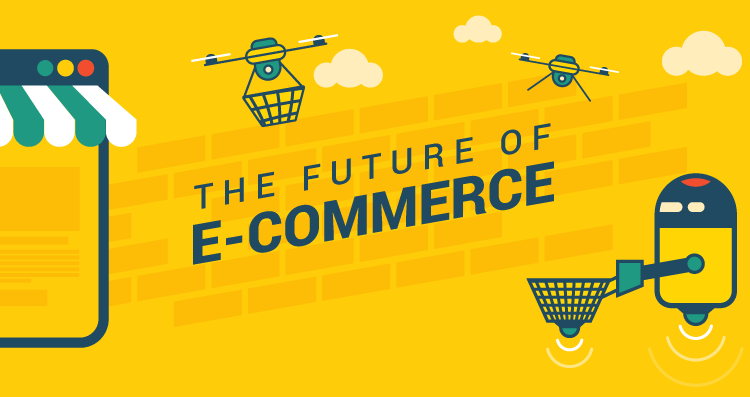
Statista projects eCommerce revenues to grow to $6.54 trillion by next year, up from $3.53 trillion in 2019. That is close to a 54% increase in revenue within a time frame of four years. You are probably wondering what could be the motivation behind such great eCommerce success. Change has been a big player in eCommerce. The giant industry is ever-evolving.
The Future of eCommerce
The ever-evolving landscape of eCommerce is both terrifying and fascinating. The transition is unstoppable. Each year comes with different changes to help grow businesses. New challenges also come in, challenges that most e-retailers might not be able to keep up with.
Whichever challenges and opportunities come in, eCommerce evolution is not stopping any soon. Brace yourself to witness even more trends in the future. As Charles Darwin says, “It is not the strongest nor the most intelligent of species that survives, but the one that is most adaptable to change.” If you want to join the list of successful eCommerce stores, you must be willing and able to adapt to change.
As already mentioned, eCommerce is trendy. 2021 has already witnessed several eCommerce trends. You should be ready to witness even more trends in the future. This article examines nine of the hottest eCommerce trends you should expect to see in 2021 and beyond.
#1. The Rise of Voice Searches
Voice searches are slowly becoming the new normal. It refers to the technology that allows you to speak to your smartphone, tablet, or laptop to search instead of typing. With the prevalence of intelligent virtual assistants such as Cortana and Amazon’s Alexa, voice search is becoming more significant, not only to eCommerce websites but also to the internet. According to PWC, 61% of online shoppers aged 25 to 64 years say they will prefer using voice searches in the future to typing. Loup Ventures also predicts that by 2025, 75% of US households will own smart speakers.
The convenience and accuracy of voice searches is why voice searches are becoming popular in eCommerce. So it is about time you started thinking about optimizing your online store for voice searches. You can follow the below three tips to optimize your eCommerce website for voice searches.
- Ensure that you optimize your content to increase your chances of appearing in voice searches.
- Introduce voice-based navigation on your eCommerce website.
- Ensure a flawless purchase experience that voice commands can necessitate.
#2. The Future of eCommerce Security
As eCommerce continues to evolve, e-merchants must and will shift their attention to the practicalities of this everchanging online buying paradigm. Customers are keen to shop on eCommerce websites, but they want to do this on their terms. They want very minimal to no disruptions and guaranteed utmost security.
What is crystal clear today is that fraud prevention and payment security will not remain static. eCommerce website owners should therefore be willing to evolve and deal with customer demands and fraudster threats.
I know for sure that online shoppers want assurance that your eCommerce website is secure. Therefore, there will be a growing need to prove your legitimacy and genuineness to your customers. This is where SSL certificates will come in. Apart from encrypting communications between your eCommerce website servers and your users’ end, the SSL certificate will also act as a trust signal on your eCommerce website. Therefore, you need to acquire a wildcard ssl certificate to secure all your first-level subdomains under the chosen main domain.
#3. The Dominance of Omnichannel Commerce
You might already have heard of the buzzword- omnichannel shopping, in your sales seminars or read it on a blog. Omnichannel commerce refers to the multichannel approach to marketing and sales where you provide your shoppers with a seamless customer experience, regardless of the channel they are using to shop.
Omnichannel commerce is becoming prevalent. A Harvard Business Review reveals that over 73% of customers use multiple channels when shopping. Although this data is over four years old, the trend shows that omnichannel customers will increase in 2021 and beyond. So it is now upon you to ensure that you offer your eCommerce shoppers a seamless shopping experience. Here are some of the tips that can help you achieve that:
- Ensure that your eCommerce website is mobile-friendly.
- Personalization of the shopping experience.
- Invest in tools such as SAP Commerce Cloud that will enhance your customer journey.
- Offer different purchase options.
#4. Integration of Artificial Intelligence
A Juniper Research Report projects that by 2022, eCommerce retailers will spend over $7.3 billion on Artificial Intelligence. Another report by ABI indicates that by 2022, over 120,000 commerce stores will be using Augmented Reality technologies to offer shoppers a perfect customer experience. Long story short, Artificial Intelligence is unstoppable in eCommerce. Any e-merchant who minds the success of his/her store should integrate AI to offer personalized guidance and product recommendations to his/her clients.
Artificial Intelligence uses past searches by the shopper to make recommendations. You should not bother your customers with suggestions that they do not want. With AI, you will be able to make product recommendations that your customers are likely to purchase. Implementing Augmented Reality alongside Artificial Intelligence will help you increase your conversion rates and revenues.
#5. The emergence of New Payment Options (The age of cryptocurrency)
One of the most vital factors that online shoppers consider before signing up with an eCommerce store is the store’s payment options. If your eCommerce store provides payment options that your customers prefer, they are more likely to purchase from you. As at this time, most eCommerce stores accept digital wallets.
Apart from digital wallets, debit, and credit cards, cryptocurrencies will dominate the payment options in the future. Crypto coins, especially Bitcoin, are gaining a lot of popularity and relevance to the public. This is because they have so many benefits to the shoppers, such as low transaction costs and no reverse transactions. In 2021 and the future, we will likely see more eCommerce stores, including cryptocurrency, as a payment option.
#6. The Rise of Mobile Commerce
M-Commerce is no doubt the future of eCommerce. More and more people now prefer using mobile devices to shop online. An App Annie’s State of Mobile 2019 report shows that the eCommerce shoppers’ total time on shopping apps in 2019 was 18 billion hours. In addition, Allied Market research projects the global mobile payment to hit $12.06 Trillion by 2027. Another interesting stat about mobile commerce projects that m-Commerce sales will hit $3.56 trillion in 2021, accounting for a 22.3% increase since 2020. As an eCommerce website owner, you have to pay much attention to making your website mobile-friendly.
#7. Ecommerce Personalization to Become more Prevalent
eCommerce personalization has become so prevalent, especially in the recent past. It is evolving into a much more sophisticated marketing strategy. eCommerce personalization is concerned with dynamically necessitating a unique and customized shopping experience. To achieve this, you will need to do your homework to ensure that you carry out individual customer analysis and develop a relevant shopping journey based on customer demographics and characteristics.
#8. Experience to Become a Driving Force
Nowadays, it is not only about the product quality or price. Customer experience is quickly emerging as a critical player in the success of eCommerce stores. In the coming years, eCommerce stores that will succeed are those that will take customer experience seriously. A positive customer experience can reduce churn, increase conversion rates, and in turn, increase revenues. There are many ways through which you can optimize the customer experience.
#9. The Growth B2B eCommerce
B2B eCommerce is the selling and marketing of products between businesses over the internet. It is different from B2C eCommerce, which is concerned with the sale of products between companies and consumers. B2B eCommerce is projected to be two times higher than B2C eCommerce. In the United States alone, Statista projects B2B sales to hit 1.184 trillion in 2022. The dominance of B2B is a wake-up for B2B businesses to up their game by ensuring a seamless shopping experience.
Conclusion
Ecommerce merchants who are willing to dominate and succeed should be ready to adapt to the latest changes as soon as possible. Failure to adopt will derail your success and can easily take you out of business. Those who are bound to succeed are those who will be quick to adapt to change. Ecommerce has already witnessed a lot of insecurity threats in the past. Hackers are relentless and are not stopping any time soon.
We can anticipate the trend to go on. To be secure, we should arm our eCommerce stores with the best security tools and protocols. Doing this won’t cost you an arm and a leg. With so many cheap wildcard ssl certificates, you can be sure to secure your eCommerce website and prove your legitimacy to your customers. Arm your eCommerce store with the nine trends explained in this article and elevate your business to new heights.

